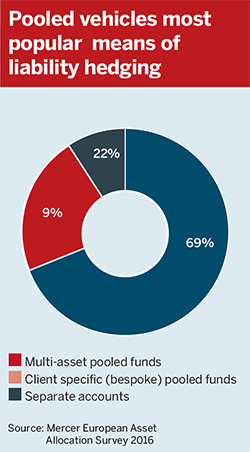The Leonardo Electronics Pension Scheme has adapted its liability hedging strategy to reflect the career salary benefit changes implemented last year to reduce risk and costs.
Cost and risk reduction is a key concern for many defined benefit pension schemes tackling large deficits amid market volatility and uncertainty.
The £747m fund, formerly known as the Selex Pension Scheme, carried out a consultation before transitioning to the career salary structure in April 2016.
We were using liability hedging in a similar way for future service benefits as is commonly done to protect past service funding positions
Mike Nixon, Finmeccanica UK
Surplus enables hedging
Members have now been informed that the scheme’s liability hedging strategy was also increased.
“The main reason for the change in liability hedge is the fact that the scheme is in surplus,” said Mike Nixon, head of pensions at sponsoring employer Finmeccanica UK.
“We wanted to make sure the proportion of the surplus allocated to cover future service benefits is sufficient at all times irrespective of movements in interest rates and inflation,” he said. “In effect we were using liability hedging in a similar way for future service benefits as is commonly done to protect past service funding positions.”
Nixon said the trustees do not have any other investment strategy changes planned in respect of the career salary structure.
Managing asset and liability risks
Alex Waite, partner at consultancy LCP, explained that, fundamentally, the main pension challenges for companies are “over-promising” benefits and “underhedging” interest rates.
While moving to career average revalued earnings addresses the issue of over-promising, hedging tackles the second problem.
“Put simply, you tend to find that a strategic review of pensions will lead to suggestions to both manage the liability risk, such as moving to Care, and the asset risk, such as increased hedging,” said Waite.
He noted that these two actions are both very likely for any company looking to proactively manage their pensions risk.

Waite explained that, unlike salary increases, Care benefits are linked to inflation, which can be modelled and hedged. Often, moving to Care will improve the funding level of the pension scheme, “as inflation increases are lower than expected salary increases, which means that hedging is more affordable”, he said.
“Essentially, spending less money on promising new benefits means more resources can be allocated to protecting the benefits that have already been built up,” Waite added.
“Some particularly risk-averse companies have pushed their hedging ratios towards 100 per cent of the liabilities, although this remains uncommon,” he said.
Triggering hedging increases
Simon Bentley, head of LDI client portfolio management at BMO Global Asset Management, also noted that moving to a career average structure can determine how much a scheme hedges.
“Generally, if you switch to a career average approach, you’re going to reduce the level of future benefits that members are going to accrue,” he said, and “the overall value of the liabilities is likely to go down”.
Selex cuts costs with new Care structure
The Selex Pension Scheme, now the Leonardo Electronics Pension Scheme, moved to a career average revalued earnings structure last year following the results of its latest triennial valuation, in an attempt to cut costs and reduce risk.
On the basis that the funding ratio will have improved, schemes typically would want to lock this in by doing more hedging in conjunction with some sort of liability management exercise, said Bentley.
“Anything that results in an increase in the funding ratio would and should trigger an increase in the amount of liability hedging that’s being done,” he said.
“If you’re fully funded, why would you run any investment or liability risk at all? You may as well derisk the scheme to the largest extent possible,” Bentley added.
Bentley said funds are generally moving to increase hedging gradually, while a few years ago a number of schemes thought interest rates would rise and therefore waited with hedging.
However, that mindset has changed, he said, and pension funds are now “doing a little bit each month” or quarter.














